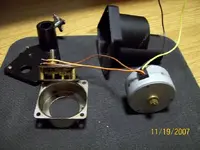It looks like it's a 2-phase 110 motor to me, but probably a rare 110 volt one that used a reduction transformer to it.. My guess is the latter. The input could be 24v, 22v, 6v, or just about anything. Ohm's Law would be useless here without knowing more than just the resistance factor.
Get an ohmeter and see if there is any real high resistance in each wire (including infinity) when two wires are connected to two separate leads. If there is, then it is shorted inside the enclosure, OR the wire has been heated to the point of deterioration. In either case it's a piece of junk now. If the resistance is between 0 and 5 ohms it's probably a low-voltage (under 24v) device. If it's rather high in all tests it's probably 110 AC.
To test it for DC, get a 9v, try that between two wires at a time, there will be 12 possible combinations, not just two. If that doesn't work you have the option to try hooking it to 110 AC directly, and in the same manor as the above. Don't try this though if you are near soil, metal, anything wet, any minerals, any other electrical equipment, or have your skin touching the wires or any of the metal housing, etc on it. If you do, you could be having your heart being used as a science project somewhere in the world by a bunch of would-be budding young physicians with awe in their eyes, thinking; "since he got here the way he did, he must have had less than a room temperature IQ anyway".
If you don't feel confident testing with 110 AC (60 cycles) then throw the thing in the trash before you kill yourself. 60 cycles matches your heartbeat enough to interrupt your heart rythm, hence easily causing death or your eyeballs being blown clear out of their sockets. On the other hand, you could be used as a human Christmas tree too and save the family $25.
Alright, I'm just kidding a little on that one..
EasyMoney






